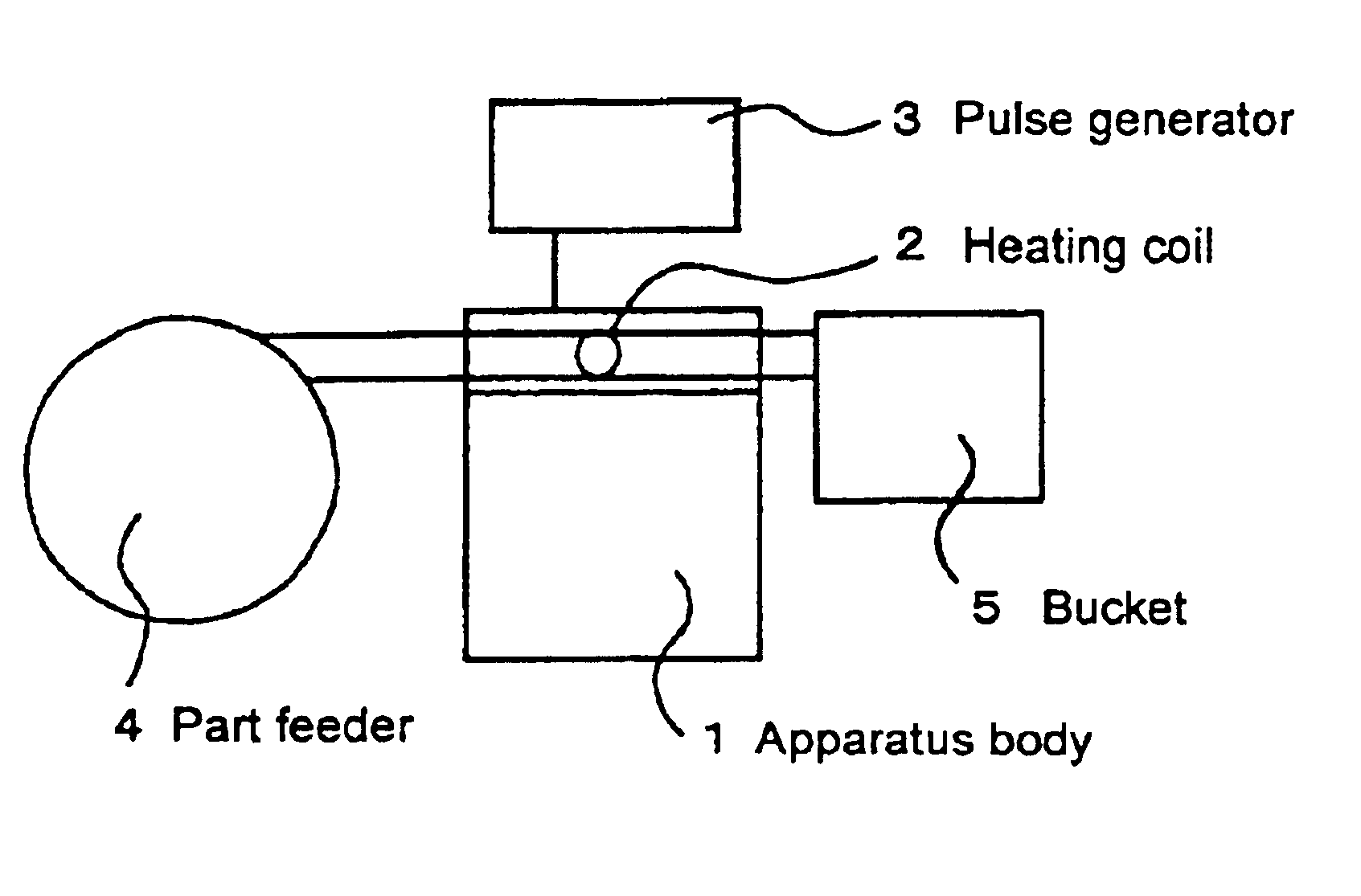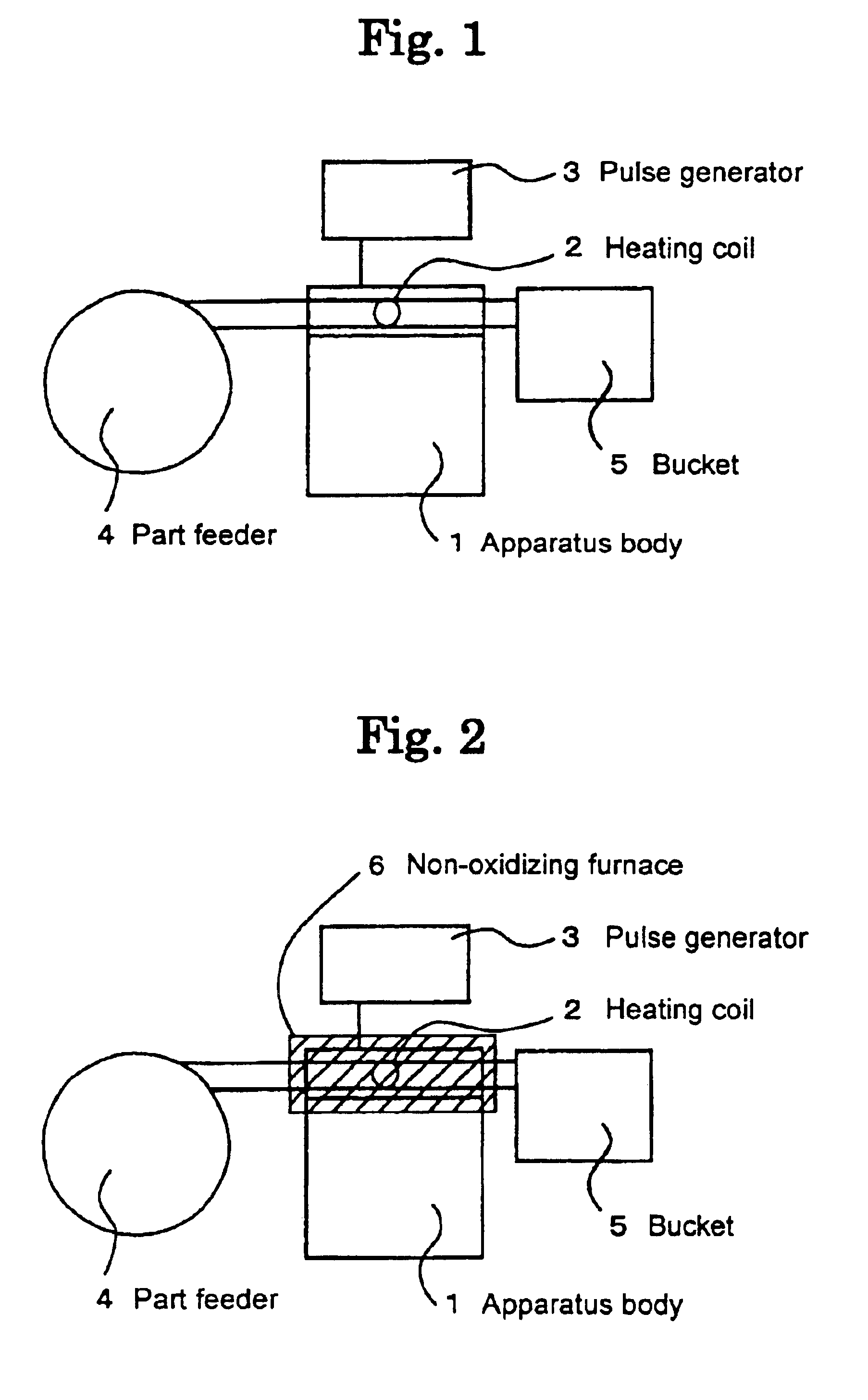Method of baking treatment of steel product parts
a technology of steel product parts and baking treatment, which is applied in the direction of heat treatment apparatus, manufacturing tools, furnaces, etc., can solve the problems of difficult to remove hydrogen from the surface, high hydrogen concentration of screws, and easy to delay the fracture of screws, so as to reduce the time required, prevent the delay of fracture, and enhance the effect of facilities
- Summary
- Abstract
- Description
- Claims
- Application Information
AI Technical Summary
Benefits of technology
Problems solved by technology
Method used
Image
Examples
example 1
M6 flat head tapping screws each having a weight of 6 g were manufactured using SAE1022 grade steel, the surfaces of the screws were galvanized in a thickness of 10 μm, and then the screw were left for 24 hours. A total of 100 Kg (16,600 pieces) of tapping screws were baked using the apparatus illustrated in FIG. 1. The frequency of the high frequency hardening apparatus body 1 was 27 MHz, and the pulse generator 3 was provided so that a rectangular pulse output having a high energy density could be oscillated for an extremely short time. Thus, heating can be turned ON and OFF 500 times per minute with a pulse output duration ranging from 1 to 100 ms, so that the surface layers of the steel parts can be rapidly heated to approximately 200° C. As a result, a time required for heating one screw was as short as approximately 0.005 seconds, so that a time required for baking the total amount of 100 kg of the tapping screws was 1.0 hour, and a significant reduction in time was achieved a...
example 2
Using the same screws as the foregoing, the surface layers of the steel parts were heated at a temperature of 250° C. for baking by the high frequency hardening apparatus body 1 at frequency of 15 KHz, which was equipped with the pulse generator 3. The remaining conditions were similar to those in Example 1. As a result, a time required for heating one screw was as short as approximately 0.45 seconds, and a time required for baking the total amount of 100 kg was 1.2 hours, thus making it possible to largely reduce the time as compared with before. Also, no head-off was observed in the salt solution immersion test, which was conducted using 100 screws.
example 3
The baking was performed in a manner similar to Example 1 except for the use of a high frequency hardening apparatus body equipped with an non-oxidizing furnace which contained a high frequency heating coil and was encapsulated with an argon gas. In this case, in spite of the fact that a time required for baking the total amount of 100 kg of tapping screws was 0.7 hours, i.e., the baking was completed in a shorter time, the head-off was not at all found in the salt solution immersion test which was conducted using 100 screws. In addition, the surfaces of the tapping screws exhibited fair surface states without generation of surface scale.
PUM
| Property | Measurement | Unit |
|---|---|---|
| Temperature | aaaaa | aaaaa |
| Frequency | aaaaa | aaaaa |
| Temperature | aaaaa | aaaaa |
Abstract
Description
Claims
Application Information
 Login to View More
Login to View More - R&D
- Intellectual Property
- Life Sciences
- Materials
- Tech Scout
- Unparalleled Data Quality
- Higher Quality Content
- 60% Fewer Hallucinations
Browse by: Latest US Patents, China's latest patents, Technical Efficacy Thesaurus, Application Domain, Technology Topic, Popular Technical Reports.
© 2025 PatSnap. All rights reserved.Legal|Privacy policy|Modern Slavery Act Transparency Statement|Sitemap|About US| Contact US: help@patsnap.com


